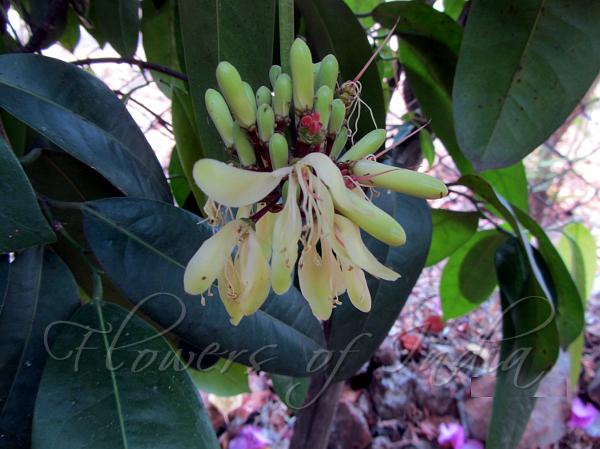|
| Niepa Bark Tree |
|

|

| File size | 620282 |
| Original date | 3/31/14 1:23 PM |
| Resolution | 2048 x 1536 |
| Flash | Flash did not fire, auto |
| Focal length | 5.0mm |
| Exposure time | 1/40s |
| Aperture | 4.0 |
| Focus Distance | |
| Metering Mode | Multi-segment |
| Camera make | Canon |
| Camera model | Canon PowerShot SX210 IS |
| Sensor type | OneChipColorArea |
|
|
|
|
Photo: |
Botanical name: Quassia indica Family: Simaroubaceae (Quassia family)
Synonyms: Samadera indica, Samadera madagascariensis
Synonyms: Samadera indica, Samadera madagascariensis
Niepa Bark Tree is an evergreen tree or shrub up to
10 m tall. Leaves are elliptic-oblong, somewhat pointed-rounded at
base, pointed to tapering at tip, leathery, hairless, shining,
netveined. Leaf-stalks are 1-2 cm long, stout. Flowers are 20 or more
in umbel-like hairless or finely velvet-hairy clusters.
Flower-cluster-stalks are 7-30 cm long, stout, flat, thick-above;
Flower-stalks are 1-1.5 cm long, to 3 cm in fruit, jointed at base;
bracts minute. Calyx 2-3 cm long, 4-lobed; sepals semiround, thick,
finely velvet-hairy outside. Petals are 4, free,
oblong-inverted-lanceshaped, blunt, 1-2 x about 0.5 cm, dorsally
velvet-hairy, white, pale yellow or purplish. Stamens are 8,
velvet-hairy. Anthers oblong-lanceshaped, 2-3 mm long; filaments finely
velvet-hairy. Ovary is about 2 mm across, finely velvet-hairy; styles
to 2 cm long, hairless. Fruits are 1-4 together, flat, smooth,
glandular and netveined. Niepa Bark Tree is found in India, Myanmar and
Sri Lanka. Flowering: All year.
Medicinal uses: The tree is considered to have
medicinal properties in Ayurved. The bark and wood are stomachic,
emmenagogue, febrifuge tonic. The leaves are useful in erysipelas and
pruritus. The seed oil is astringent, acrid, thermogenic, depurative,
emetic, purgative and febrifuge. It is useful in vitiated conditions of
vata kapha, leprosy, scabies, pruritus, skin diseases, constipation and
bilious fever.
The tree is considered to have
medicinal properties in Ayurved. The bark and wood are stomachic,
emmenagogue, febrifuge tonic. The leaves are useful in erysipelas and
pruritus. The seed oil is astringent, acrid, thermogenic, depurative,
emetic, purgative and febrifuge. It is useful in vitiated conditions of
vata kapha, leprosy, scabies, pruritus, skin diseases, constipation and
bilious fever.
Medicinal uses:
 The tree is considered to have
medicinal properties in Ayurved. The bark and wood are stomachic,
emmenagogue, febrifuge tonic. The leaves are useful in erysipelas and
pruritus. The seed oil is astringent, acrid, thermogenic, depurative,
emetic, purgative and febrifuge. It is useful in vitiated conditions of
vata kapha, leprosy, scabies, pruritus, skin diseases, constipation and
bilious fever.
The tree is considered to have
medicinal properties in Ayurved. The bark and wood are stomachic,
emmenagogue, febrifuge tonic. The leaves are useful in erysipelas and
pruritus. The seed oil is astringent, acrid, thermogenic, depurative,
emetic, purgative and febrifuge. It is useful in vitiated conditions of
vata kapha, leprosy, scabies, pruritus, skin diseases, constipation and
bilious fever. | Identification credit: Nandan Kalbag | Photographed in Pune, Maharashtra, |
• Is this flower misidentified? If yes,